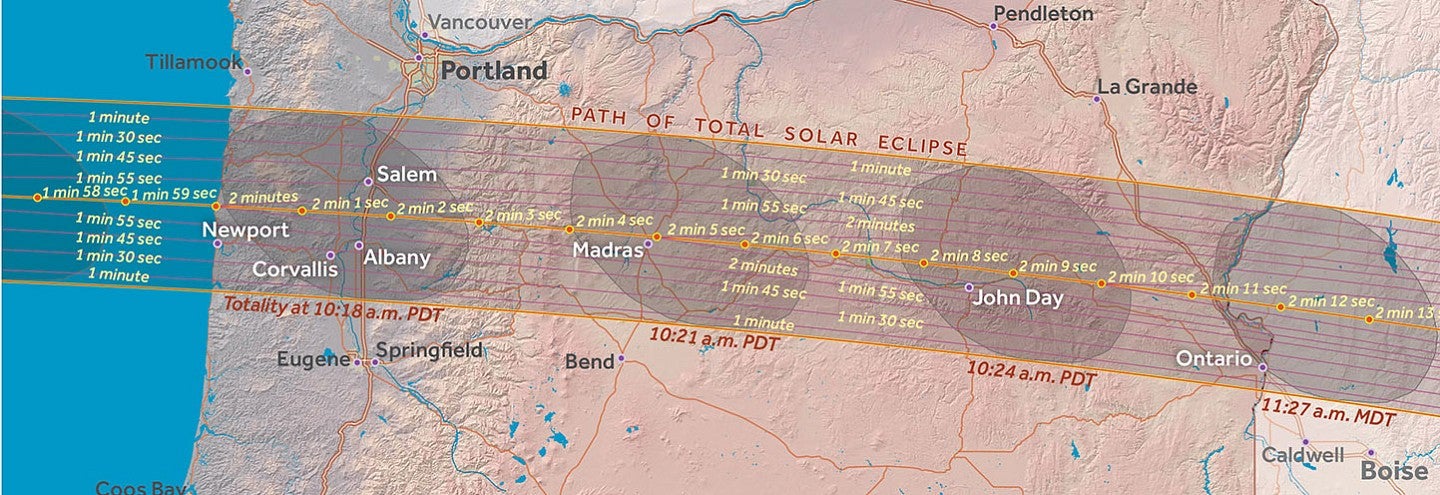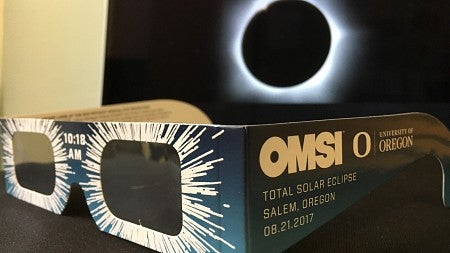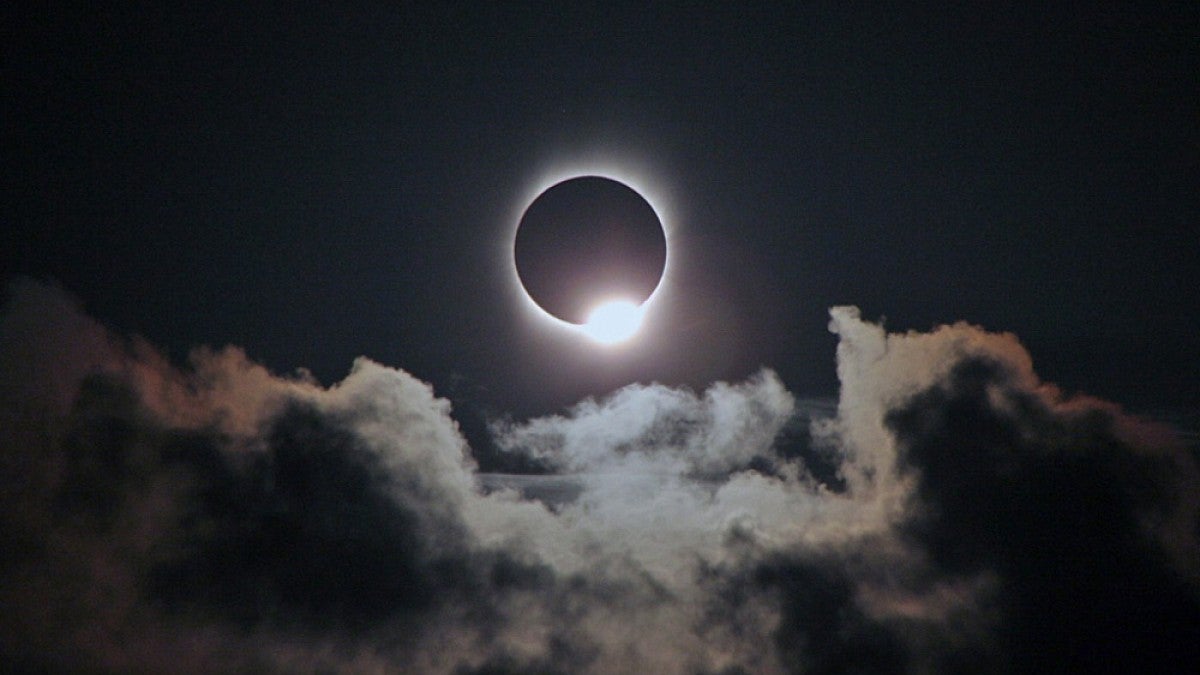Everyone is an astronomer, according to UO astrophysicist Scott Fisher
“It’s embedded in our minds in a deep way,” he said. “We go out and look up at the sky.”
With millions upon millions of people planning to do exactly that during this summer’s North American solar eclipse, Fisher might be onto something.
ECLIPSE EVENTS
Aug. 1, 6 p.m.
Scott Fisher, "Path of Totality"
Portland Science Night
Widmer Brothers Brewing
SOLD OUT
Aug. 3, 3 p.m.
Scott Fisher, “Darkness in Daytime: Viewing the August Total Solar Eclipse”
Museum of Cultural and Natural History
University of Oregon
Aug. 9, 6 p.m.
Scott Fisher, “Darkness in Daytime: The Science of the August Eclipse”
Falling Sky Pizzeria, EMU
University of Oregon
Aug. 16, 6 p.m.
Jim Brau, “Total Solar Eclipse of 2017”
Eugene Public Library
Aug. 21, 8 a.m.
Jim Brau, “Solar Science"
OMSI Solar Eclipse Viewing Party
L.B. Day Amphitheater
Oregon State Fair and Expo Center Salem
SOLD OUT
Roughly one million of these aspiring astronomers will do their sun-gazing in Oregon, parts of which are situated in the eclipse’s path of totality where the moon will completely cover the sun. The eclipse will travel across the entire continent, but its first landfall is in Oregon, where it can be seen from within a band that stretches about 60 miles wide and includes Corvallis, Prineville and Baker City. Eugene and Portland are both several miles outside its boundaries.
Fisher’s best advice for the eclipse: “Just watch it.”
And listen to it and feel it. According to Fisher, the solar eclipse will be a full sensory experience as day becomes night for just over two minutes. Nocturnal creatures will sound off, stars and planets will shine bright, and the temperature will plummet several degrees as the moon becomes the sky’s starring act.
“It’s a life experience that you have to witness to understand why people are so hooked,” he said.
To best understand the eclipse, interested sun-gazers can attend one of several talks that UO physicists are delivering in August. Fisher will be leading three different discussions in Eugene and Portland to give people the lowdown on the low-light event.
Fisher will be experiencing the sights and sounds of the eclipse from the small town of Madras in central Oregon. The drive from Eugene is normally about three hours, but Fisher will give himself close to two days to reach his viewing spot, and urges anyone interested in catching some sun to do the same. With 100 million people living within an eight-hour drive of the eclipse’s path through Oregon, he suspects Interstate 5, along with the roads through the Cascades, could turn into more of a parking lot than a highway.
UO physics undergraduate student Charity Woodrum will be joining Fisher in Madras. She recommends doing whatever it takes to watch the eclipse from within totality, because the viewing experience will be drastically diminished, even at 99 percent of totality.
“Even 1 percent of the sun is really bright,” she said.
Woodrum says that there are eclipse “hounds” that find totality so appealing, they go to great lengths to view rare solar events. Some fans will travel around the world to catch them. Eclipses actually average 2.4 per year, but with 80 percent of the Earth covered by water, many never pass above land. Especially fanatical groups have even chartered a plane to fly alongside the path of totality to extend their viewing time.

UO particle physicist Jim Brau will be immersed in the sold-out crowds, delivering a speech on solar science at the OMSI Solar Eclipse Viewing Party in Salem, which is the first of five state capitals that the total eclipse will visit Aug. 21. He will also give a talk at the Eugene Public Library on Aug. 16 at 6 p.m. to help audience members understand the science behind the solar eclipse.
Brau finds the sheer coincidence of the solar eclipse one of its most fascinating features.
“The moon only exists because the Earth collided with something the size of Mars 4.5 billion years ago, and that collision created matter that coalesced into the moon,” Brau explains. “That random collision created a moon that just so happens to be 400 times smaller than the sun and is now 400 times closer to the Earth. This exact ratio is the only reason the moon is able to block the sun in its entirety.”

While the distant future of solar eclipses is a bit bleak, they enjoy a rich history.
“People actually used a solar eclipse to prove one of Einstein’s theories, the curving of spacetime,” Fisher said.
The credibility of Einstein’s theory of relativity was increased during a solar eclipse in 1919. Scientists tested the impact of the sun’s gravity on light by measuring the position of clusters of stars both before and during the eclipse.
“The gravity of the sun changed the apparent position of the stars, which were visible thanks to the darkness during the eclipse,” he explains. “By measuring the difference in two pictures, they saw that Einstein was right about spacetime.”
The year before that monumental eclipse, the United States was focused on an eclipse set to cross Oregon in June. Congress appropriated a hefty sum of money to the U.S. Naval Observatory to observe the total eclipse from Baker City, but it might not have given enough consideration to the unpredictable weather in the Pacific Northwest.
“It turned out to be a little bit of a disappointment. The clouds came in and obscured the sun,” Brau said.
Centuries ago, eclipses contributed to a conversation about the existence of extraterrestrial life. Dutch scientist Christiaan Huygens believed extraterrestrial life on Jupiter and Saturn must enjoy daily eclipses of their moons, due to orbit patterns. In the 17th century, he argued that astronomy on Earth likely began as an attempt to explain and predict eclipses, which meant civilizations on Jupiter and Saturn must be very sophisticated at astronomy, given the high frequency of eclipses.
“Such texts spinning out wild theories about extraterrestrial customs on the basis of our few shared experiences, such as eclipses, were not necessarily an attempt to write an extraterrestrial anthropology,” UO historian Vera Keller said. “They were an effort to decenter Earth’s perspective and to open everything believed about the cosmos up to question.”
These days, there is less revolutionary science and conjecture taking place during the eclipse because astronomers have a solid understanding of planetary orbits and the solar eclipse itself. Scientists have been able to accurately predict these solar events since the 1800s.
But for newcomers to sky-gazing, the eclipse is just one element of astronomy and related science, especially for those in Oregon. The state is one of the last bastions of dark skies in the country and offers both aspiring and professional astronomers some of the best terrain to view the night sky all summer long.
— By Emily Halnon, University Communications


